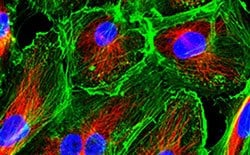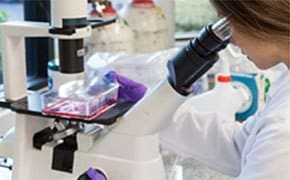Primary Cell Culture

An Overview of Primary Cells
Primary cells are mammalian cells that are harvested directly from living human or animal tissues. They differ from stem cells in that non-stem primary cells are typically terminally differentiated and are therefore considered closely representative of the tissues from which they are isolated, particularly where characteristics of cancer biology may make cancer cell lines less predictive models of normal systems or noncancer pathologies. Common primary cell phenotypes include epithelial, endothelial, keratinocytes, melanocytes, fibroblasts, osteoblasts, myocytes, and hepatocytes.
Related Technical Articles
- What are primary cells? A comprehensive overview of animal and human primary cell lines and media and how they are used in biomedical cell culture applications. Primary cultures are less homogeneous relative to cell lines.
- Primary human fibroblasts and growth medium for the in vitro cultivation of juvenile and adult fibroblasts. Protocols for handling, cell passaging, media, and product use.
- The PromoCell Primary Cancer Culture System allows selective isolation of malignant cancer cells from tumor associated stromal cells in patient derived xenographs (PDX models) and tumor samples.
- Enzyme Explorer Key Resource: Collagenase Guide.Collagenases, enzymes that break down the native collagen that holds animal tissues together, are made by a variety of microorganisms and by many different animal cells.
- Primary human airway epithelial cells and serum-free growth media are optimized for the in vitro cultivation of epithelial cells from large air passages. Protocols for handling, cell passaging, media, and product use.
Related Protocols
- Human Umbilical Vein Endothelial Cells (HUVEC) Culture Protocol. Storage. Preparation for Culturing. Store the cryovials in a liquid nitrogen storage tank immediately upon arrival.
- Ficoll 400® is a highly branched polymer formed by the copolymerization of sucrose and epichlorohydrin. Ficoll 400® is completely non-ionic. Because of the abundance of hydroxyl groups, Ficoll 400® is very hydrophilic and extremely water-soluble.
- Generate phagocytic M1 and M2 macrophages from human PBMCs in 10 days in serum-free and xeno-free cell culture media. Explore over 350 PromoCell products.
- Osteogenesis, adipogenesis and chondrogenesis differentiation protocols and media for human mesenchymal stem cell culture. Explore over 350 PromoCell products on our company website.
- Store the cryovials in a liquid nitrogen storage tank immediately upon arrival.

How Primary Cells Differ from Immortalized Cell Lines
Like cell lines derived from tumors or immortalized by other methods, primary cells from human or animal sources provide a method for modeling biological systems. Because they are typically viable for fewer doublings, primary cells are less susceptible to the loss of tissue-specific traits that can characterize cells cultured over long periods of time and repeated passages in vitro. Primary cells may be documented with donor characteristics, including age, gender, and disease state where applicable, and may therefore prove useful models for the development of personalized medicine approaches.
Sourcing and culturing primary cells
Research institutions associated with hospitals may have access to primary tissues and cells. Primary cell suppliers offer cell lots from individual donors or cells pooled from multiple donors. Reputable suppliers or patient collection protocols should include documentation demonstrating ethical oversight for the isolation of cells from human donors, as well as validation of cell type. Primary cells differ from mammalian cell lines in that they are generally more fastidious, requiring extra nutrients, particularly when cultured in media that is low in serum or serum-free. These additional, defined nutrients include cytokines and growth factors.
To continue reading please sign in or create an account.
Don't Have An Account?